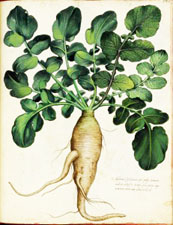Rustic Roots:
Parsnips & Turnips
By Audrey Stallsmith


Mute as a turnip from the Fourth
Of July to All Fools' Day. . .
from "You're" by Sylvia Plath
In the above poem, Plath compares an infant in the womb to a turnip which also grows quietly, submerged. And, as turnips are frequently left in the ground over winter, such a vegetable could--conceivably!--grow for nine months as well.
The Fourth of July might be a bit early for the turnip's inception, though. As my father would tell you, the old adage goes, "On the 25th of July, sow your turnips wet or dry." Though he will admit that any date in July will probably do!
After recently enjoying some parsnips and turnips in a savory stew, I've been puzzled about why these particular root vegetables have declined so much in popularity. At the supermarket, it took me a while to find them because they were tucked away on the shelf of exotic vegetables--and packaged only three to a bag.
We will probably have to blame the potato. Before its advent, parsnips and turnips--far from being exotics--were staples in Europe, especially among the poor. After all, you don't have to worry about storage space for vegetables that can be left in the ground! Parsnips originally went by the same name as carrots, and must have looked quite similar, since carrots weren't orange back then. These days, parsnips are called Pastinacea sativa, from pastus ("food") and sativa ("cultivated").
Herbalist John Gerard held, in the late 1500's, that 'The Parsneps nourish more than do the Turneps or the Carrots, and the nourishment is somewhat thicker. . ." Another herbalist, Tournefort, reported in the early 1700's that "'they are commonly boiled and eaten with butter in the time of Lent; for that they are the sweetest, by reason the juice has been concocted during the winter, and are desired at that season especially, both for their agreeable Taste and their Wholesomeness. For they are not so good in any respect, till they have been first nipt with Cold."
That cold turns many of the starches in these root vegetables into sugars, which explains why they taste better if left out! Parsnips, in fact, were often used as a sweetener before sugar became widely available. And they are still frequently served glazed like carrots. Their affinity for butter is obvious in the old saying that "fine words butter no parsnips." While still tender, they can be served raw as well, though their core will eventually grow tough.
Besides being diuretic, parsnips are high in Vitamin C, fiber, folate, and potassium. They are frequently recommended as a remedy for stones of the kidney and gallbladder. And parsnip seeds will reportedly cure fevers.
Turnips, being from the cabbage family, are officially known as Brassica rapa. Their greens, though somewhat bitter, share the family trait of being very good for you. They are high in Vitamins K, A, & C. And the bitterness reportedly comes from their being rich in calcium as well. While the sweet turnip "bulbs" can boast lots of Vitamin C, phosphorus, and fiber.
The purple "crowns" on Milan turnips are actually a form of sunburn. Eaten raw, turnips will reportedly clean the teeth and massage the gums. And John Heinerman suggests applying turnip juice to one's underarms to control odor. Though it won't actually stop the sweat--just deodorize it!
Once parsnips and turnips became less popular as people provender, they were still grown to feed livestock. Horses, cows, and pigs, knowing a good thing when they see it, will gobble them right up. Which is why one of the characters in Lucy Maud Montgomery's Anne of the Island could report that "Herb Blewett fell off the hayloft last Wednesday, and rolled right down through the turnip chute into the box stall, where they had a fearful wild, cross horse, and rolled right under his heels. And still he got out alive, with only three bones broke. Mrs. Lynde says there are some folks you can't kill with a meat-axe."
Twain's Huckleberry Finn brags that "We used to hop out of the woods and go charging down on hog-drivers and women in carts taking garden stuff to market, but we never hived any of them. Tom Sawyer called the hogs 'ingots,' and he called the turnips and stuff 'julery,' and we would go to the cave and powwow over what we had done."
These associations with rural life probably explain why the phrase "just fell off the turnip truck" came to be associated with us country bumpkins. Though I don't know any farmers around here who still grow turnips--even for livestock feed. That leaving them in the ground all winter idea would probably work better further south anyway.
But, since I obviously have rustic tastes, maybe I could try sneaking a few parsnips and turnips into our garden next summer. I could probably protect them with bales over the winter, if need be. At least that would go some way towards explaining the "hayseed in my hair!"
Parsnip and turnip images are from Italian Fruits and Vegetables by Ulisse Aldrovandi.








